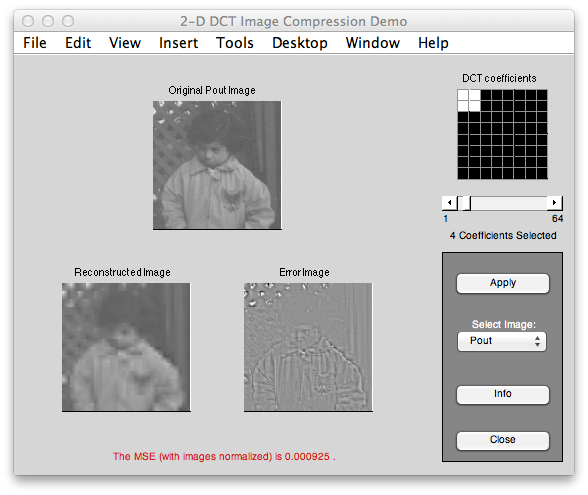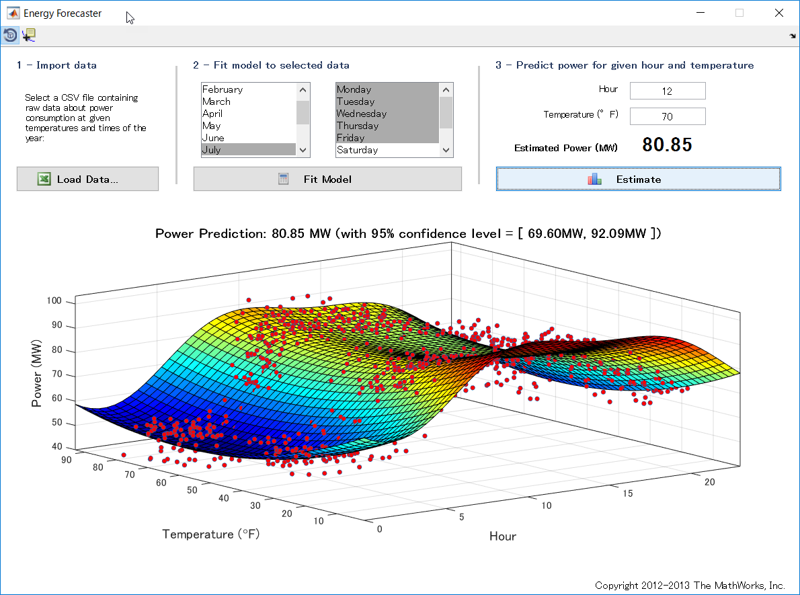Revisiting dctdemo – part 2
This is the second part of my plan to rewrite an Image Processing Toolbox example from 20 years ago using more modern MATLAB language features.
Recall the old app I'm trying to reinvent:

The idea is to experiment with the basic principles of DCT-based image compression. I've decided that I don't want to copy this original layout and functionality exactly. For one thing, computers (and MATLAB!) are a lot faster than they were 20 years ago, and I think we really don't need a separate "Apply" button.
Here's my first attempt at sketching what I'd like to make this time around.

The truth, is, I'm making the code and these posts up as I go along. So far I've only had a chance to get some of the initial pieces up and working. But it's enough to start exploring some of the coding ideas.
Here's what happens when I call the app class, which I've called (for now) dctCompressionExample_v2.
app = dctCompressionExample_v2
app =
dctCompressionExample_v2 handle
Properties:
OriginalImage: [240x240 double]
ReconstructedImage: []
ErrorImage: []
DCTCoefficientMask: []
NumDCTCoefficients: 10

You can see I got some output in the Command Window, and I also got a new figure on the screen.
Here's the code so far.
classdef dctCompressionExample_v2 < handle
properties (SetAccess = private)
OriginalImage
ReconstructedImage
ErrorImage
DCTCoefficientMask
end properties
NumDCTCoefficients = 10
end properties (Access = private)
Slider
OriginalImageAxes
ReconstructedImageAxes
ErrorImageAxes
MaskAxes
end methods
function this_app = dctCompressionExample_v2
this_app.OriginalImage = initialImage;
layoutApp(this_app);
update(this_app);
end function layoutApp(app)
f = figure;
app.OriginalImageAxes = axes('Parent',f, ...
'Position',[0.12 0.56 0.28 0.28]);
app.ReconstructedImageAxes = axes('Parent',f, ...
'Position',[0.60 0.56 0.28 0.28]);
app.MaskAxes = axes('Parent',f, ...
'Position',[0.12 0.16 0.28 0.28]);
app.ErrorImageAxes = axes('Parent',f, ...
'Position',[0.60 0.16 0.28 0.28]);
app.Slider = uicontrol('Style','slider', ...
'Value',app.NumDCTCoefficients/64, ...
'Units','normalized', ...
'Position',[0.12 0.08 0.28 0.04], ...
'Callback',@(~,~,~) app.reactToSliderChange);end
function reactToSliderChange(app)
v = get(app.Slider,'Value');
app.NumDCTCoefficients = round(64*v);
update(app);
end function update(app)
imshow(app.OriginalImage,'Parent',app.OriginalImageAxes);
title(app.OriginalImageAxes,'Original Image'); imshow(app.OriginalImage,'Parent',app.ReconstructedImageAxes);
title(app.ReconstructedImageAxes,'Reconstructed Image'); imshow(zeros(size(app.OriginalImage)),'Parent',app.ErrorImageAxes);
title(app.ErrorImageAxes,'Error Image'); imshow(zeros(size(app.OriginalImage)),'Parent',app.MaskAxes);
title(app.MaskAxes,'DCT Coefficient Mask');
drawnow;
end
endend
function I = initialImage
pout = imread('pout.tif');
pout2 = pout(1:240,:);
I = im2double(adapthisteq(pout2));
endAt this point I'll remind you of Dave Garrison's article that I mentioned last time. This article teaches about how this kind of code works. I don't intend to repeat all of that article here. I'll just point out a few things.
Here's the function that runs when you launch the app.
function this_app = dctCompressionExample_v2
this_app.OriginalImage = initialImage;
layoutApp(this_app);
update(this_app);
endinitialImage is a little function I stuck at the bottom of the file. It's purpose is to create our sample image, which for the purpose of this simple DCT demonstration needs to be a multiple of 8-by-8 in size. (Plus, I threw in a call to adapthisteq because the original image has low contrast.)
function I = initialImage
pout = imread('pout.tif');
pout2 = pout(1:240,:);
I = im2double(adapthisteq(pout2));
endThen there's the properties block.
properties (SetAccess = private)
OriginalImage
ReconstructedImage
ErrorImage
DCTCoefficientMask
end properties
NumDCTCoefficients = 10
end properties (Access = private)
Slider
OriginalImageAxes
ReconstructedImageAxes
ErrorImageAxes
MaskAxes
endSome of the properties, such as OriginalImage, I want to make accessible but read-only. Some of them, such as OriginalImageAxes, are private because they are only needed by the guts of the app. Notice that one of them, NumDCTCoefficients, is both readable and settable. I wanted to explore the idea of giving this app a little programmable interface so that you can write code to make it change.
I would like to make it so that the NumDCTCoefficients property changes when you drag the slider. Here's how to accomplish that:
app.Slider = uicontrol('Style','slider', ...
'Value',app.NumDCTCoefficients/64, ...
'Units','normalized', ...
'Position',[0.12 0.08 0.28 0.04], ...
'Callback',@(~,~,~) app.reactToSliderChange);Setting the 'Callback' property of the slider like this causes the app's function reactToSliderChange to get called whenever the slider is dragged. Here's what reactToSliderChange does:
function reactToSliderChange(app)
v = get(app.Slider,'Value');
app.NumDCTCoefficients = round(64*v);
update(app);
endNow we're starting to get a little interactivity going in our app.
That's about as far as I got this week. Next time we'll continue wiring things up and maybe start putting in some algorithmic DCT block processing code.







댓글
댓글을 남기려면 링크 를 클릭하여 MathWorks 계정에 로그인하거나 계정을 새로 만드십시오.